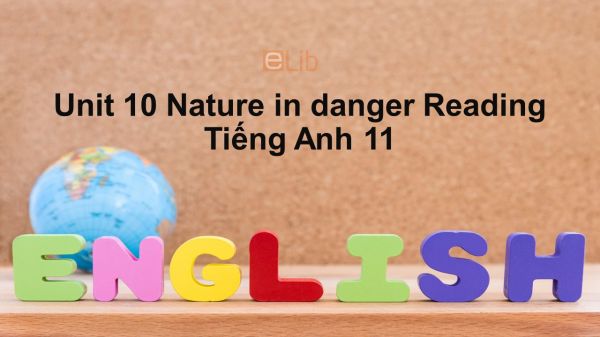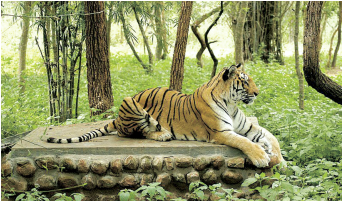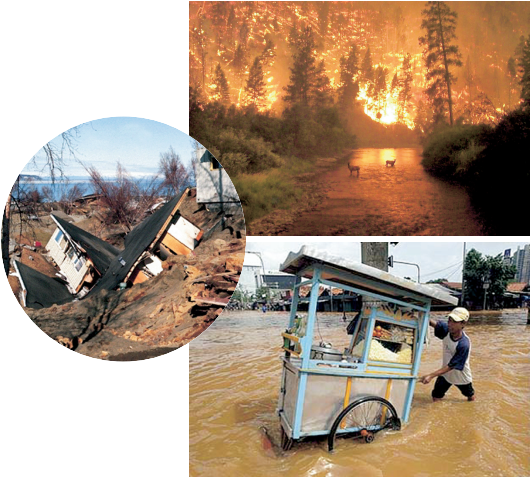Unit 10 lớp 11: Nature in danger-Reading
Bài học Unit 10 lớp 11 "Nature in danger" phần Reading giúp các em cải thiện kỹ năng đọc hiểu qua nội dung các bài đọc về tầm quan trọng của môi trường thiên nhiên.
Mục lục nội dung

1. Before You Read Unit 10 lớp 11
Tạm dịch
- Loài báo bây giờ chỉ sống rải rác ở Đông Phi mặc dù trước đây đã có một thời có thể tìm thấy ở khắp nơi trên Châu Phi và Châu Á.
- Người ta ước tính chỉ có 1 000 con gấu trúc còn lại ở vùng hoang dã.
- Có chỉ khoảng 20 con hổ Si-bê-ri còn lại trong vùng hoang dã ở Trung Quốc và vào khoảng 100 con sống ở các sở thú Trung Quốc và các vườn quốc gia.
1. What do you understand from the facts above?
(Bạn hiểu gì từ những thực tế trên?)
2. Can you explain why the numbers of these animals have become small?
(Bạn có thể giải thích số lượng những con vật này vì sao ngày càng nhỏ?)
Guide to answer
1. The facts above show that the numbers of some wild/ rare animals such as cheetahs, pandas and Silberian tigers have become small/ extinct.
(Những chi tiết trên cho thấy số lượng một số số loài động vật hoang dã/ quý hiểm như báo, gấu trúc và hổ Siberian đang trở nên tuyệt chủng.)
2. The numbers of these animals have become small because they are killed for food, fur or skin.
(Số lượng những loài này đang giảm dần vì chúng bị giết để làm thực phẩm, lông và da.)
2. While You Read Unit 10 lớp 11
Read the passage, and then do the tasks that follow (Đọc đoạn văn, và sau đó làm các bài tập theo sau)
The human race is only one small species in the living world. Many other species exist on this planet. However, human beings have a great influence on the rest of the world. They are changing the environment by building cities and villages where forests once stood. They are affecting the water supply by using water for industry and agriculture. They are changing weather conditions by cutting down trees in the forests. And they are destroying the air by adding pollutants to it.
It can be said that human beings are changing the environment in all respects through their actions and by their habits. This has resulted in two serious consequences. The first is that many kinds of rare animals are killed. The second is that the environment where these animals are living is badly destroyed. As a result, the number of rare animals is decreasing so rapidly that they are in danger of becoming extinct.
In order to make sure that these rare animals do not disappear, efforts have been made to protect the environments in which they live. Scientists have made lists of endangered species and suggested ways to save them. Many organisations have been set up and funds have been raised. Thousands of national parks all over the world have been established to protect endangered animals. Laws have been introduced to prohibit the killing of endangered animals and the destruction of the environments where these rare animals are living.
If people's interference with the environment decreases, more species will survive and produce offspring. The Earth will be a happy planet where human beings, animals and plants peacefully co-exist.
Tạm dịch
Con người chỉ là một chủng loại sinh vật bé nhỏ trong thế giới sống. Còn có nhiều chủng loại khác hiện hữu trên hành tinh này. Tuy nhiên con người có ảnh hưởng lớn tới phần còn lại trên thế giới. Họ thay đổi môi trường bằng cách xây dựng thôn làng và thành phố nhà cửa nơi đã từng là rừng rậm. Họ đang tác động tới nguồn nước bằng cách lấy nước dùng cho công nghiệp và nông nghiệp. Họ đang thay đổi thời tiết bằng việc đốn cây trong rừng, và họ đang hủy diệt không khí bằng cách thải chất gây ô nhiễm vào không khí.
Có thể nói rằng con người đang thay đổi môi trường sống về mọi mặt qua hành động và thói quen của họ. Điều đó đã đưa đến hai hậu quả nghiêm trọng. Thứ nhất là nhiều loại thú quý hiếm đã bị tiêu diệt. Thứ nhì là môi trường nơi các sinh vật ấy sống đang bị hủy hoại một cách tồi tệ. Kết quả là số lượng thú quý hiếm đang giảm nhanh đến đỗi chúng có nguy cơ bị tuyệt chủng.
Để bảo đảm các loài thú quý hiếm đó không bị biến mất, nhiều nỗ lực đã được thực hiện để bảo vệ môi trường sống của chúng. Các nhà khoa học đã lập một danh mục các loài thú đang có nguy cơ tuyệt chủng và đề nghị các biện pháp để bảo vệ chúng. Hàng ngàn công viên quốc gia đã được thiết lập trên khắp thế giới để bảo vệ các loài động vật có nguy cơ tuyệt chủng. Nhiều luật lệ đã được đặt ra để nghiêm cấm việc giết hại các loài động vật có nguy cơ tuyệt chủng và cấm tàn phá môi trường nơi các loài thú quý hiếm đang sống.
Nếu sự can thiệp của con người vào môi trường giảm xuống, thì sẽ có nhiều chủng loại tồn tại và sinh con đẻ cháu. Trái đất sẽ là hành tinh hạnh phúc nơi mà con người, muôn thú và cây cối sẽ cùng tồn tại trong hòa bình.
2.1. Task 1 Unit 10 lớp 11
The words in the box all appear in the passase. Fill each blank with a suitable word
(Những từ trong khung xuất hiện trong đoạn văn. Điền vào mỗi chỗ trống với một từ thích hợp)
1. Dinosaurs became ______ millions of years ago.
2. She tried to ______ herself from the wind.
3. This species of bird is ______ in numbers every year.
4. The chemical ______ from cars and factories make the air, water and soil dangerously dirty.
5. The blue whale is a(an) ______ species.
6. Because of the ______ of human beings, many animals have become extinct.
Guide to answer
1. Dinosaurs became extinct millions of years ago.
(Khủng long đã tuyệt chủng cách đây hàng triệu năm.)
2. She tried to protect herself from the wind.
(Cô ấy cố gắng bảo vệ mình khỏi những cơn gió.)
3. This species of bird is decreasing in numbers every year.
(Loài chim này đang giảm về số lượng hàng năm.)
4. The chemical pollutants from cars and factories make the air, water and soil dangerously dirty.
(Ô nhiễm hóa chất từ ô tô và nhà máy khiến không khí, nước và đất bị ô nhiễm một cách nghiêm trọng.)
5. The blue whale is a(n) endangered species.
(Cá voi xanh là một loài đang bị đe dọa.)
6. Because of the interference of human beings, many animals have become extinct.
(Vì sự tác động của con người, nhiều loài động vật đã trở nên tuyệt chủng.)
2.2. Task 2 Unit 10 lớp 11
Circle A, B, C or D that best sums up each paragraph (Khoanh tròn A, B, C hoặc D thể hiện ý chính của mỗi đoạn văn)
1. Paragraph 1
A. Human beings need to grow food.
B. Human beings pollute the environment.
C. Human beings interfere with nature.
D. People should stop living in cities and villages.
2. Paragraph 2
A. Many animals are disappearing.
B. Human beings are responsible for the changes in the environment.
C. People are in danger of becoming extinct.
D. The human race is also an endangered species.
3. Paragraph 3
A. Human beings have made efforts to protect the environment.
B. Scientists have made a long list of endangered species.
C. People should be kept away from animals and plants.
D. Rare animals do not disappear.
4. Paragraph 4
A. The survival of endangered species
B. The Earth - a happy planet
C. Conditions for a peaceful co-existence
D. People’s interference with the environment
Guide to answer
1. C
Human beings interfere with nature
(Con người đang can thiệp/tác động đến tự nhiên)
2. B
Human beings are responsible for the changes in the environment.
(Con người chịu trách nhiệm cho các thay đổi môi trường)
3. A
Human beings have made efforts to protect the environment.
(Con người đang nỗ lực để bảo vệ môi trường)
4. C
Conditions for a peaceful co-existence
(Các điều kiện cho sự chung sống hòa bình)
2.3. Task 3 Unit 10 lớp 11
Answer the questions
(Trả lời các câu hỏi)
Guide to answer
1. What are the four ways by which human beings are changing the world?
(Con người đang làm thay đổi thế giới theo 4 cách nào?)
⇒ Four ways that people change the world are:
(Bốn cách mà con người đang làm thay đổi thế giới là:)
- They are changing the environment by building cities and villages where forests once stood. (Họ đang thay đổi môi trường bằng việc xây dựng các thành phố và làng mạc nhà cửa nơi đã từng là rừng rậm.)
- They are affecting the water supply by using water for industry and agriculture. (Họ đang tác động tới nguồn nước bằng cách lấy nước dùng cho công nghiệp và nông nghiệp.)
- They are changing weather conditions by cutting down trees in the forests. (Họ đang thay đổi điều kiện thời tiết bằng việc đốn cây trong rừng.)
- They are destnoying the air by adding pollutants like smoke from factories to it. (Họ đang hủy diệt không khí bằng cách thải chất gây ô nhiễm như là khói từ các nhà máy vào không khí.)
2. What are the serious consequences of people's interference with the environment?
(Những hậu quả nghiêm trọng của sự can thiệp của con người đến môi trường là gì?)
⇒ The serious consequences of people's interference with the environment are:
(Những hậu quả nghiêm trọng của sự can thiệp của con người đến môi trường là:)
- Many kinds of rare animals are killed. (Nhiều loại thú quý hiếm đã bị tiêu diệt.)
- The environment where these animals are living is badly destroyed. (Môi trường nơi các sinh vật ấy sống đang bị hủy hoại một cách tồi tệ.)
- The numbers of rare animals is decreasing so rapidly that they are in danger of becoming extinct. (Số lượng thú quý hiếm đang giảm nhanh đến đỗi chúng có nguy cơ bị tuyệt chủng.)
3. What has been done to protect the environment? (Những biện pháp gì đã được thực hiện để bảo vệ môi trường?)
⇒ Many things have been done to protect endangered nature, such as:
(Nhiều biện pháp đã được thực hiện để bảo vệ môi trường tự nhiên đang bị đe dọa như là:)
- Many organizations have been set up and money has been raised to save rare animals. (Nhiều tổ chức đã được thành lập và gây quỹ để cứu các loài động vật quý hiếm.)
- Thousands of national parks have been established. (Hàng ngàn công viên quốc gia đã được thiết lập.)
- Laws have been passed to prohibit killing endangered animals and the destruction of the environment where these animals are living. (Nhiều luật lệ đã được đặt ra để nghiêm cấm việc giết hại các loài động vật có nguy cơ tuyệt chủng và cấm tàn phá môi trường nơi các loài thú quý hiếm đang sống.)
3. After You Read Unit 10 lớp 11
Work in groups. Find out why some animals have become extinct (Làm việc nhóm. Tìm xem tại sao một số loài động vật đã bị tuyệt chủng)
Guide to answer
Some animals have become extinct because: (Một số động vật tuyệt chủng vì:)
- People hunt or capture animals for skin, food, recreation or entertainment. (Con người săn bắn hoặc bắt động vật lấy da, thức ăn, thú tiêu khiển hoặc giải trí.)
- Climate changes and Disease. (Thay đổi khí hậu và dịch bệnh.)
- People are destroying the natural environment: by cutting down trees in the forests, by adding chemical pollutants, ... (Con người đang phá hủy môi trường tự nhiên: bằng cách chặt hạ cây trong rừng, thải ra các chất thải hóa học…)
- People's interference with the environment cause many natural disasters: flood, forest fire,... (Sự tác động của con người đến môi trường gây ra nhiều thảm họa thiên nhiên: lũ lụt, cháy rừng…)
4. Practice Task 1
Read the passage carefully, then choose the correct answers (Đọc đoạn văn sau đó trả lời câu hỏi)
The natural world is under violent assault from man.
The seas and rivers are being poisoned by radioactive wastes, by chemical discharges and by the dumping of dangerous toxins and raw sewage. The air we breathe is polluted by smoke and fumes from factories and motor vehicles; even the rain is poisoned.
It's little wonder forests and lakes are being destroyed and everywhere wildlife is disappearing. Yet the destruction continues.
Governments and industries throughout the world are intensifying their efforts to extract the earth's mineral riches and to plunder its living resources. The great rainforests and the frozen continents alike are seriously threatened. And this despite the warnings of the scientific community and the deep concern of millions of ordinary people.
Despite the fact, too, that we can create environmentally-clean industries, harness the power of the sun, wind and waves for our energy needs and manage the finite resources of the Earth in a way that will safeguard our future and protect all the rich variety of life forms which share this planet with us.
But there is still hope. The forces of destruction are being challenged across the globe - and at the spearhead of this challenge is Greenpeace.
Wherever the environment is in danger, Greenpeace has made a stand.
Its scientific presentations and peaceful direct actions at sea and on land have shocked governments and industries into an awareness that Greenpeace will not allow the natural world to be destroyed. Those actions, too, have won the admiration and support of millions.
Now you can strengthen the thin green line; you can make your voice heard in defence of the living world by joining Greenpeace today. Thank God someone's making waves.
1. Which of these statements is not made?
A. Drinking water is polluted.
B. Radioactive waste poisons the sea.
C. Sewage isn't processed.
D. Cars and factories poison the air.
2. The writer............
A. is surprised that the rain is poisoned.
B. is unsured why the air is polluted.
C. wonders why the natural world is being destroyed.
D. understands why forests and lakes are being destroyed.
3. Rainforests are being destroyed because governments and industries.......
A. are unaware of what they're doing wrong.
B. are rich and powerful.
C. choose to ignore criticism.
D. basically care about the environment.
4. The earth's resources..........
A. should only be for people
B. can be made to last longer.
C. will last forever.
D. belong to just humans and animals
5. Governments and industries............
A. don't know what Greenpeace thinks.
B. are forced to understand the problems by Greenpeace.
C. can easily ignore Greenpeace.
D. misunderstand what Greenpeace thinks.
5. Practice Task 2
Read the passage carefully, then choose the correct answers (Đọc đoạn văn sau đó trả lời câu hỏi)
Since the world became industrialized, the number of animal species that have either become extinct or have neared extinction has increased. Bengal tigers, for instance, which 'once roamed the jungles in vast numbers, now number only about 2,300. By the year 2025, it is estimated that they will become extinct.
What is alarming about the case of the Bengal tiger is that this extinction will have been caused almost entirely by poachers who, according to some sources, are not always interested in material gain but in personal gratification. This is an example of the callousness that is contributing to the problem of extinction. Animals such as the Bengal tiger, as well as other endangered species, are valuable parts of the world's ecosystem. International laws protecting these animals must be enacted to ensure their survival - and the survival of our planet.
Countries around the world have begun to deal with the problem in various ways. Some countries, in an effort to circumvent the problem, have allocated large amounts of land to animal reserves. They then charge admission prices to help defray the costs of maintaining the parks, and they often must also depend on world organizations for support. This money enables them to invest in equipment and patrols to protect the animals. Another response to the increase in animal extinction is an international boycott of products made from endangered species. This has' had some effect, but by itself It will not prevent animals from being hunted and killed.
1. What is the main topic of the passage?
a. The Bengal tiger
b. International boycotts
c. Endangered species
d. Problems with industrialization
2. The word 'poachers' used in line 7 could be best replaced by which of the followings?
a. Illegal hunters
b. Enterprising researchers.
c. Concerned scientists
d. Trained hunters
3. What is an act of cruelty according to the passage?
a. Having interest in material gain.
b. Hunting endangered animals.
c. Killing animals for personal satisfaction.
d. Causing the problem of extinction..
4. Which of the following is not mentioned in the passage as a way to protect animals from extinction?
a. Introduce laws to prohibit the killing of endangered animals.
b. Establish wildlife reserves.
c. Refuse to buy animal products.
d. Raise money to invest in equipment and patrol.
5. Which of the following best describes the author's attitude?
a. Forgiving
b. Surprised
c. Vindictive
d. Concerned
6. The soybean, a plant native to China and Japan, has become ______ in the United States farming community.
a. one of the most popular crops
b. as one of the most popular crops
c. only of the most popular crops
d. one popular crops most are in
7. Declared an endangered species in the United States, ______.
a. people have gathered the ginseng root almost to the point of extinction
b. the near extinction of the ginseng root is due to excessive gathering
c. the ginseng root has been gathered almost to the point of extinction
d. gathering the ginseng root almost to the point of extinction.
8. Of all the endangered South American birds, the jacana has been _____.
a. difficult the most to protect
b. protected the most difficult
c. to protect the most difficult
d. the most difficult to protect
9. ______, Luxor did not reach preeminence until about 2000 B. C. E.
a. Many centuries earlier it was founded
b. Although founded many centuries earlier
c. The city founded centuries earlier
d. Founding the city centuries earlier.
10. Deep in the Rio Bec area of Mexico's Yucatan Peninsula ______.
a. does a 1,250-year-old pyramid lie
b. lies a 1,250-year-old pyramid
c. a 1,250-year-old pyramid lie
d. is a 1,250-year-old pyramid lying
Để nâng cao kĩ năng đọc hiểu với chủ đề "Nature in danger", mời các em cùng đến với đề kiểm tra trắc nghiệm Unit 10 Reading Tiếng Anh 11 sau đây và cùng luyện tập.
7. Conclusion
Qua bài học này các em cần lưu ý các từ vựng như sau
- affect [ə'fekt] (v): ảnh hưởng
- Africa ['æfrikə] (n): châu Phi
- agriculture ['ægrikʌlt∫ə] (n): nông nghiệp
- cheetah ['t∫i:tə] (n): con báo gêpa
- co-exist [kou ig'zist] (v): sống chung, cùng tồn tại
- consequence ['kɔnsikwəns] (n): kết quả
- destruction [dis'trʌk∫n] (n): sự phá hủy
- dinosaur ['dainəsɔ:] (n): khủng long
- disappear [,disə'piə] (v): biến mất
- effort ['efət] (n): nỗ lực
- endangered [in'deindʒə(r)d] (adj): bị nguy hiểm, bị đe dọa
- estimate ['estimit - 'estimeit] (v): ước tính
- exist [ig'zist] (v): tồn tại
- extinct [iks'tiηkt] (adj): tuyệt chủng
- habit ['hæbit] (n): thói quen
- human being ['hju:mən 'bi:iη] (n): loài người
- human race ['hju:mən'reis] (n): nhân loại
- in danger ['deindʒə] (exp): có nguy cơ
- industry ['indəstri] (n): công nghiệp
- interference [,intə'fiərəns] (n): sự can thiệp
- offspring ['ɔ:fspriη] (n): con cháu, dòng dõi
- panda ['pændə] (n): gấu trúc
- planet ['plænit] (n): hành tinh
- pollutant [pə'lu:tənt] (n): chất gây ô nhiễm
- prohibit [prə'hibit] (v) : ngăn cấm
- rare [reə] (adj): hiếm
- respect [ri'spekt] (n): khía cạnh
- responsible [ri'spɔnsəbl] (adj): trách nhiệm
- scatter ['skætə] (v): phân tán
Tham khảo thêm
- doc Unit 10 lớp 11: Nature in danger-Speaking
- doc Unit 10 lớp 11: Nature in danger-Listening
- doc Unit 10 lớp 11: Nature in danger-Writing
- doc Unit 10 lớp 11: Nature in danger-Language Focus







.png)
